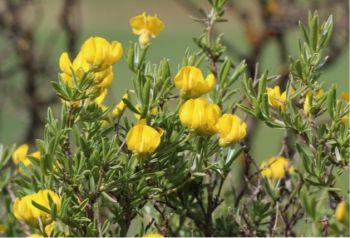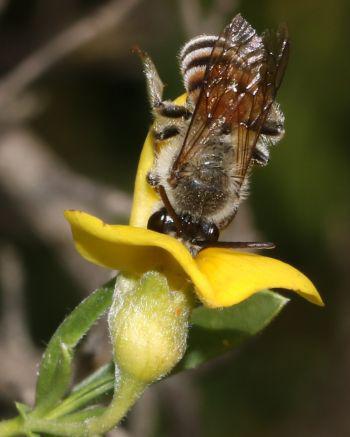Polhillia ignota
Polhillia ignota Boatwr.
Family: Fabaceae
Common names: due to the rarity of this species, there are no common names recorded for it.
Introduction
Only known from two records made over 80 years ago, this lost species was recently rediscovered by the Custodians of Rare and Endangered Wildflowers (CREW). This species occurs in critically endangered Swartland Shale Renosterveld and is in need of immediate conservation interventions to ensure that it is not lost to us again.

Description
Description
A large, rounded shrub, up to 1 m in height. Branches are hairy when young, becoming less hairy with age. Leaves are trifoliolate, silvery hairy, with the petioles shorter than the leaf. Stipules are triangle shaped (deltoid) and divided into two branches (bifurcate). Young leaves are strongly folded, whereas mature leaves are flattened. Inflorescences are yellow and terminal, on short shoots up to 15 mm long, with 2–4 flowers per shoot. Pedicels are 1–2 mm long. Flag or standard petal hairy on the back surface. Calyx is up to 4 mm long, very hairy and 2-lipped.

Conservation Status
Status
This species was only rediscovered in September 2016, and at the time of writing the article (24 October 2016), the Red List status was still listed as Extinct (EX). Due to the rediscovery of the species and the new data that has been collected, this species will be listed as Critically Endangered (CR) in the 2016 update of the National Red List. This species has lost more than 90% of its habitat and only 13 plants are known to survive on a small renosterveld fragment less than 3 ha in size.

Distribution and habitat
Distribution description
Polhillia ignota is known to occur along the west coast, between Vredenburg and Porterville. Due the vague locality details of the historical records, we cannot pinpoint the exact locality of those collections. The discovery of the new population close to Eendekuil, corroborates the historical occurrence of the species at Porterville. Thus far we only have habitat information for the population that occurs at Eendekuil. It occurs on a south-facing slope, along a brackish stream, south of Eendekuil. The soil is not typical renosterveld clay soil, but has a layer of granitic loam over clay. Close to the site, are also white, quartz outcrops and this may have an influence on the soil composition.
Derivation of name and historical aspects
History
Polhillia ignota was known from two collections made in 1909 from Hoedjies Bay and 1928 from Porterville. This species was first included with Lebeckia waltersii (now Polhillia obsoleta), but was different enough to be separated as a distinct species. It was not formally described at the time because more material was expected to be found, but after numerous searches, the plants could not be relocated. It was formally described in 2009 to ensure that it could be listed on the National Red List for South African Plants. This species was rediscovered in September 2016.
The genus Polhillia is named after Roger M. Polhill, a botanist at the Royal Botanic Gardens, Kew, and an expert in legumes. The specific epithet, ignota is Latin and means ‘unknown’, ‘unacquainted with’ or ‘ignorant of’, referring to its rarity, and very recent rediscovery.

Ecology
Ecology
This species is extremely rare and it was only rediscovered in September 2016, so studies need to be conducted to find out pollination and dispersal mechanisms. While photographing the plants when it was rediscovered, we did notice several bees visiting the plants. See more photos of its rediscovery.
Uses
Use
Due to its rarity, no uses for this plant have been recorded.
Growing Polhillia ignota
Grow
Thus far we have only managed to germinate seeds and grow the plant from seeds collected in April 2016. Seeds were removed from the pods and planted into seed trays in April. Seeds germinated after approximately 2 weeks. There are only thirteen plants in the wild, so we have not experimented with taking cuttings yet. It is a resprouter and should grow easily by cuttings. The plant is a large, attractive shrub (as well as some of its sister species) and could have horticultural potential.
References
- Boatwright, J.S. 2010. A rare new species of Polhillia (Genisteae, Fabaceae). South African Journal of Botany 76(1): 142–145
- Boatwright, J.S., Helme, N.A. & Raimondo, D. 2014. Polhillia ignota Boatwr. National Assessment: Red List of South African plants version 2015.1. Accessed on 2016/10/31.
- Jackson, W.P.U. 1990. Origins and meanings of names of South African plant genera. University of Cape Town.
Credits
Ismail Ebrahim
Custodians of Rare and Endangered Wildflowers (CREW)
November 2016
Plant Attributes:
Plant Type: Shrub
SA Distribution: Western Cape
Soil type: Sandy, Clay
Flowering season: Spring
PH: Acid
Flower colour: Yellow
Aspect: Full Sun
Gardening skill: Average
Special Features:
Horticultural zones







Rate this article
Article well written and informative
Rate this plant
Is this an interesting plant?
Login to add your Comment
Back to topNot registered yet? Click here to register.